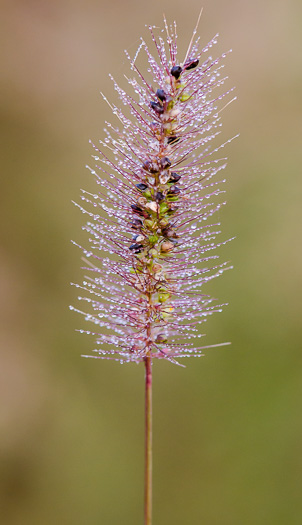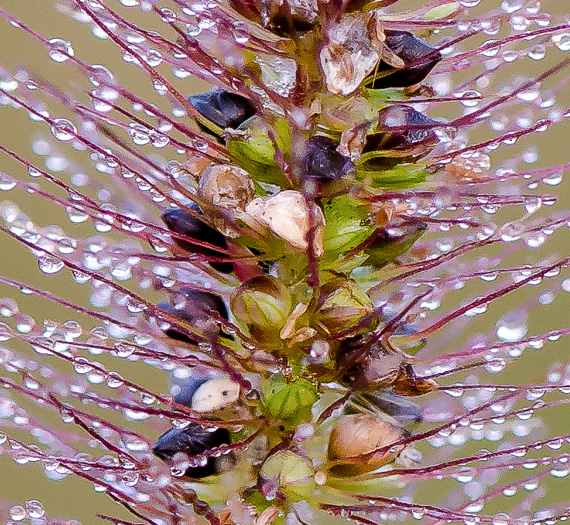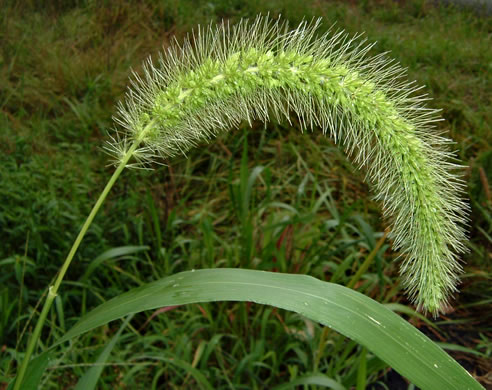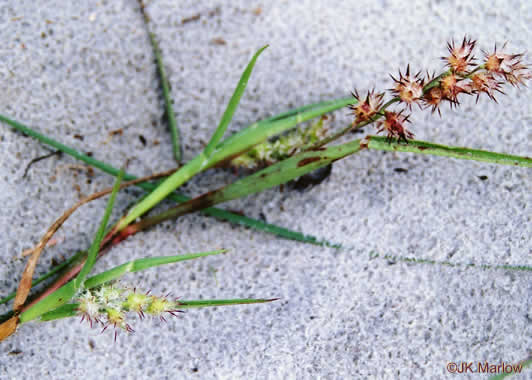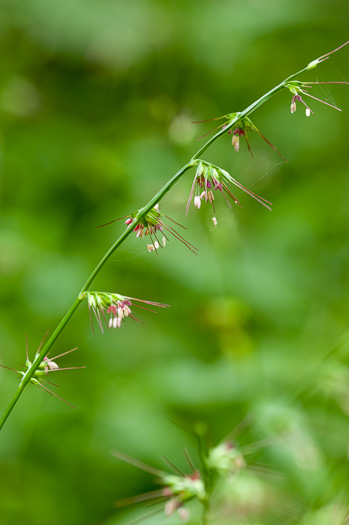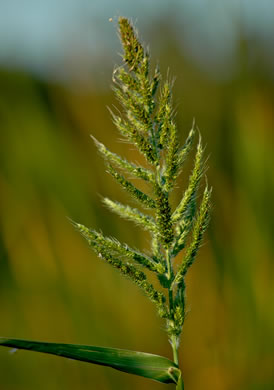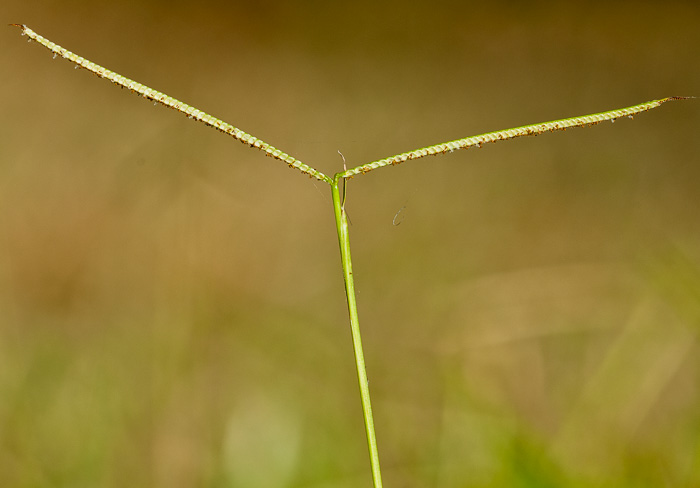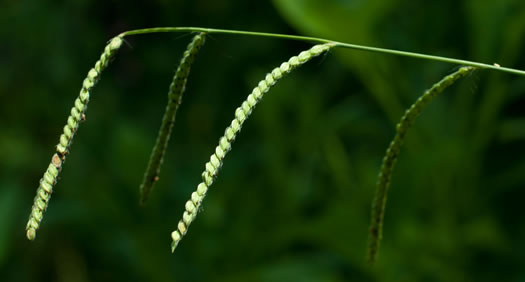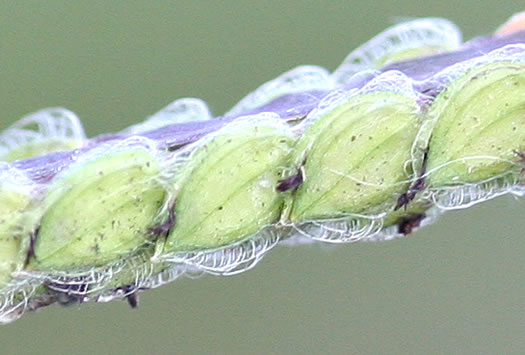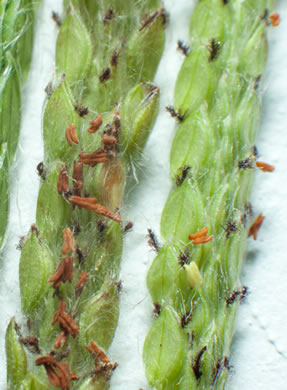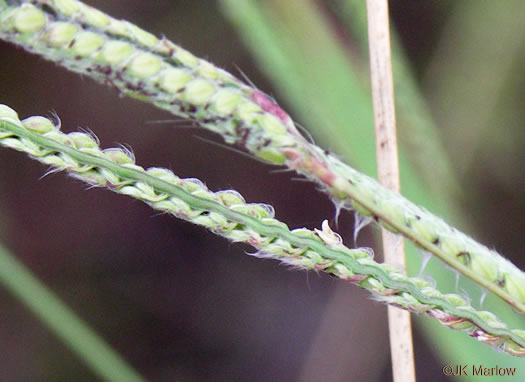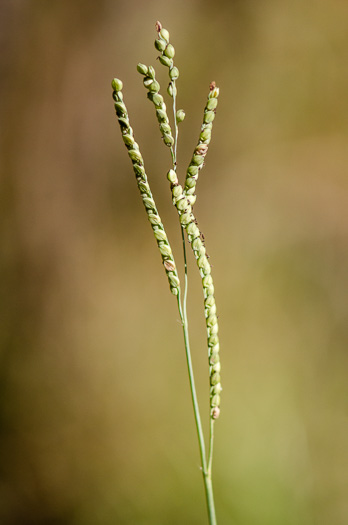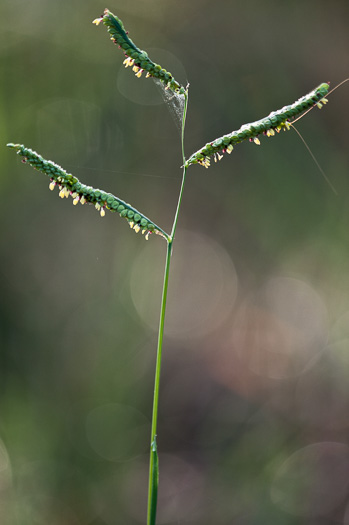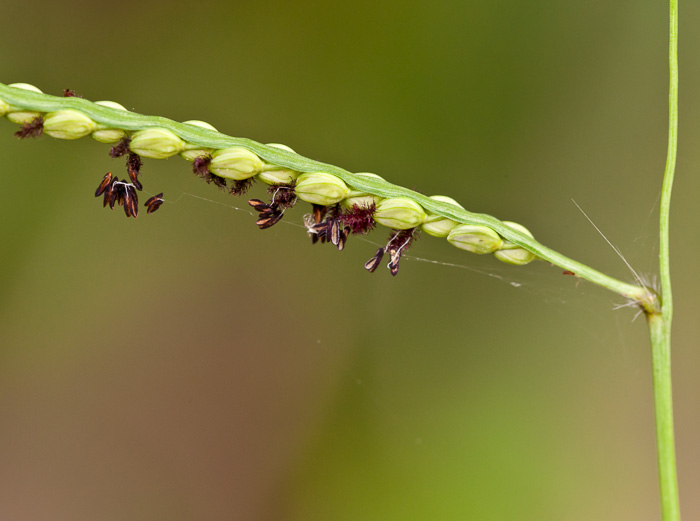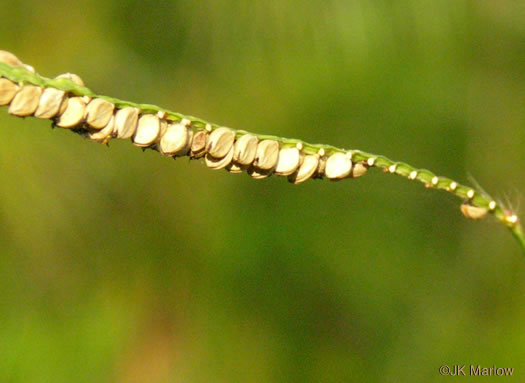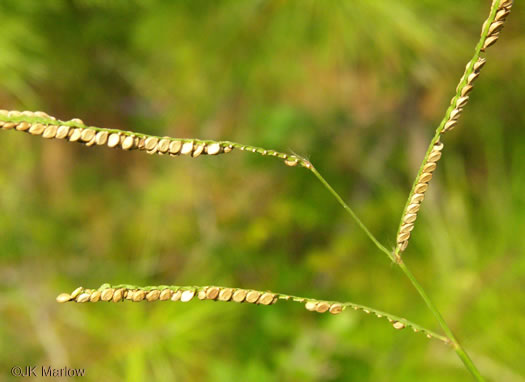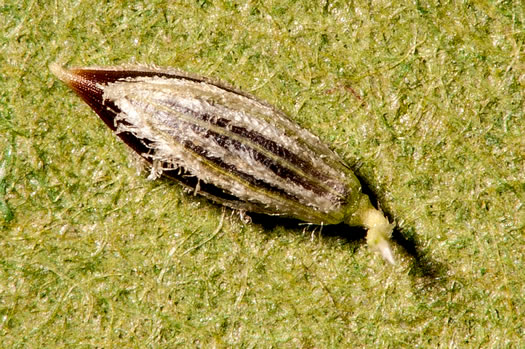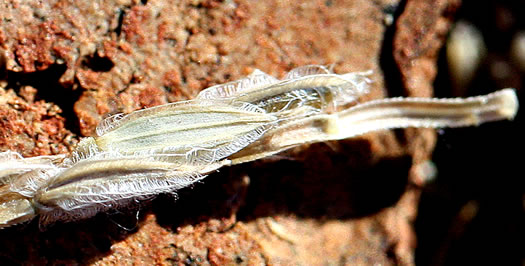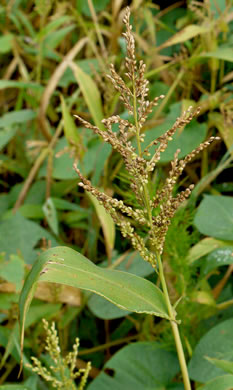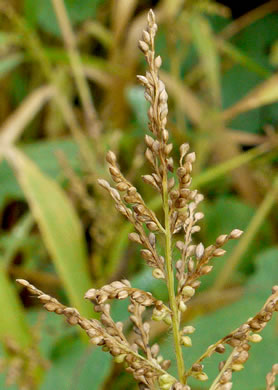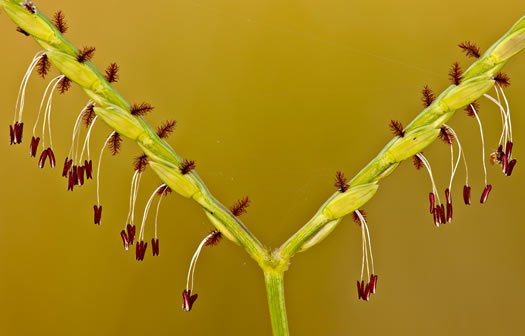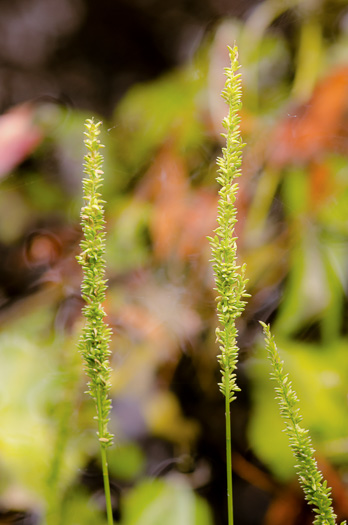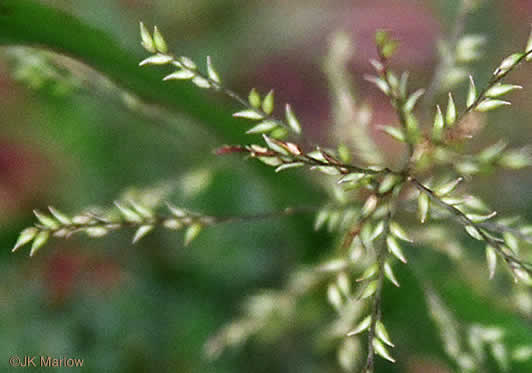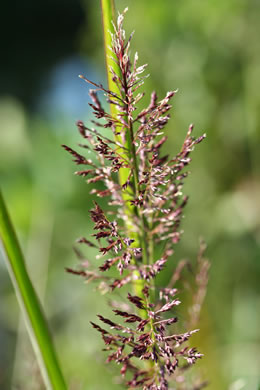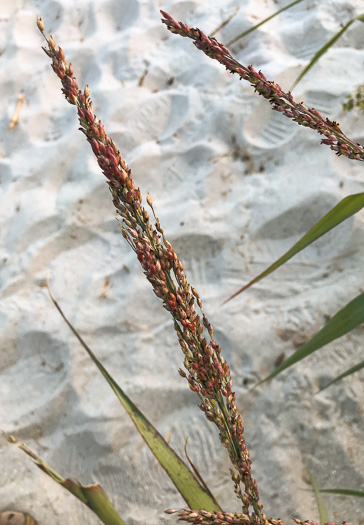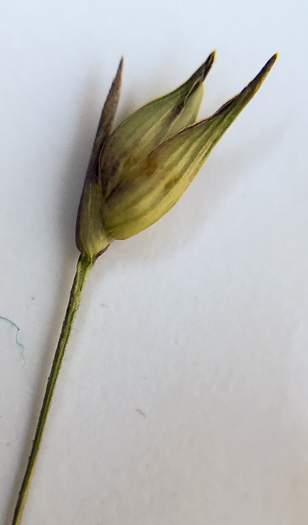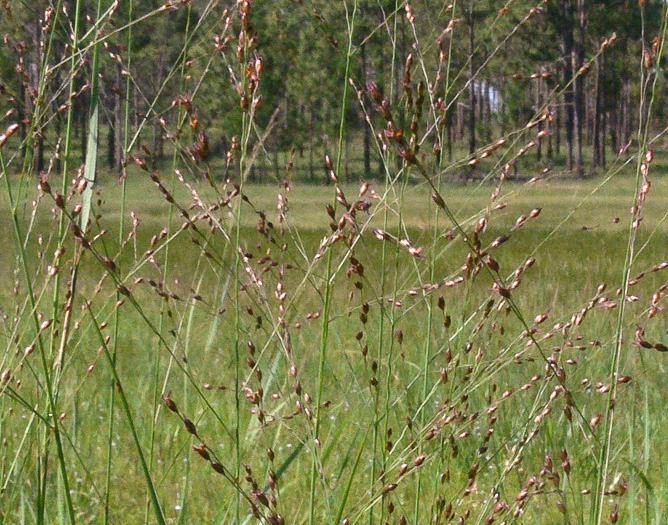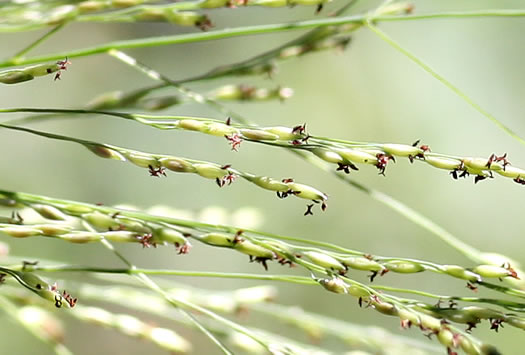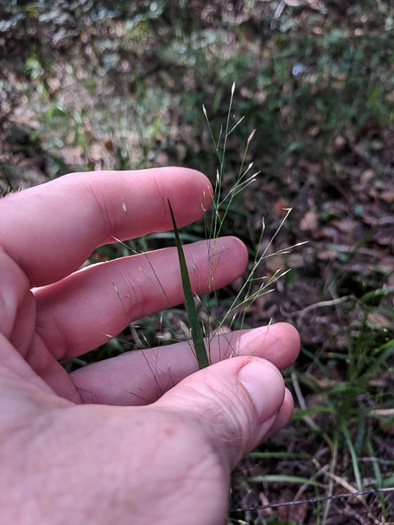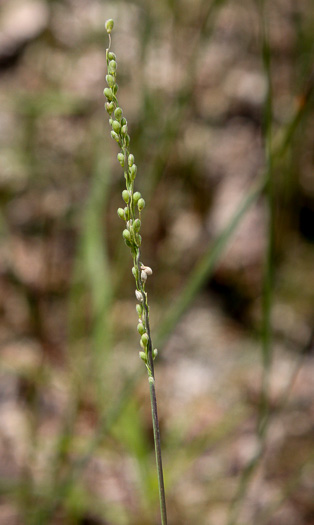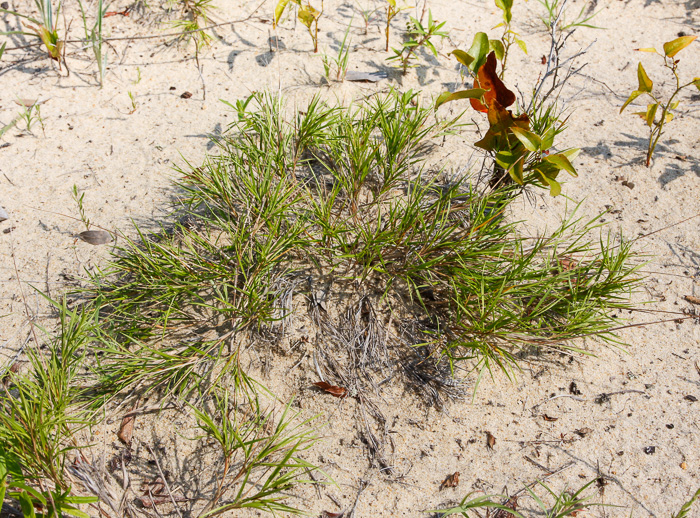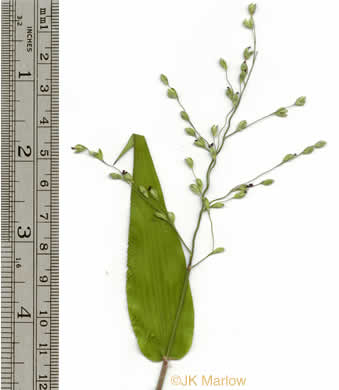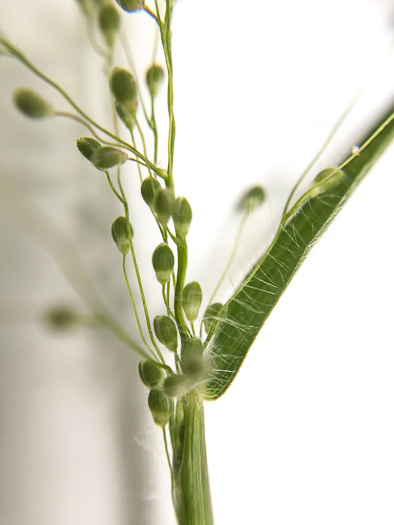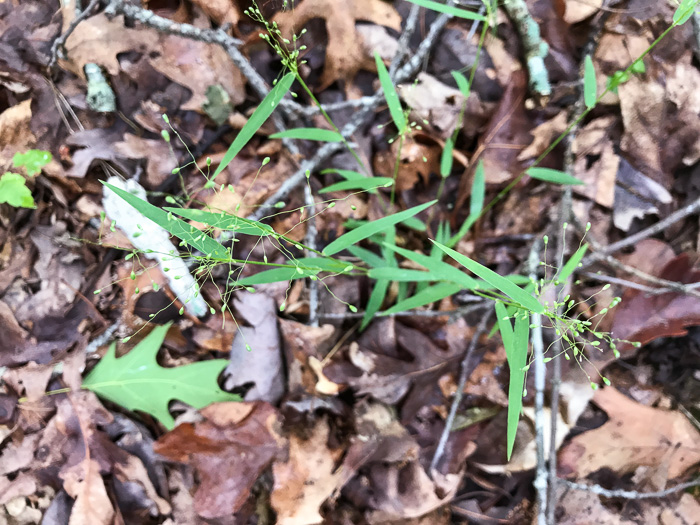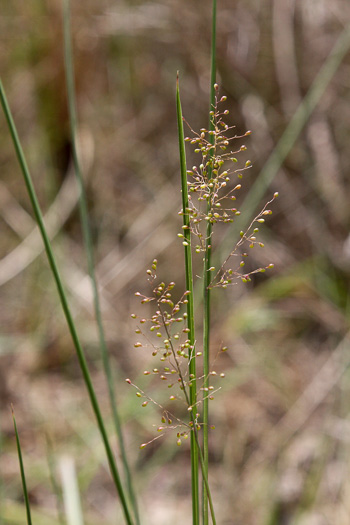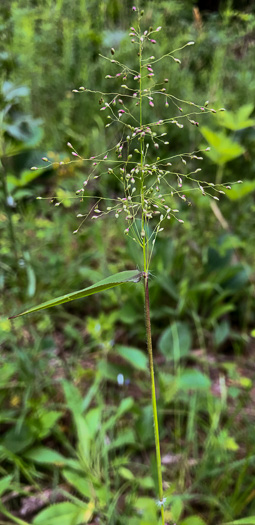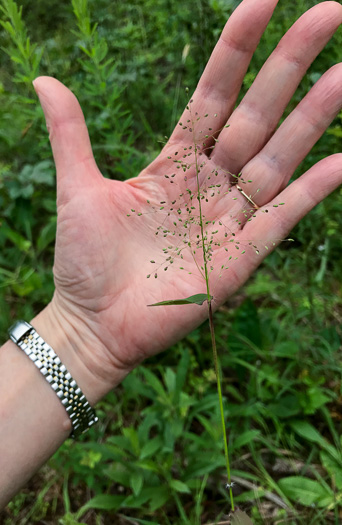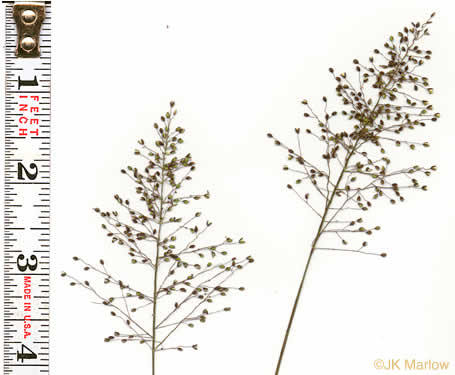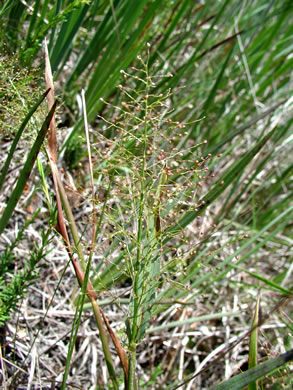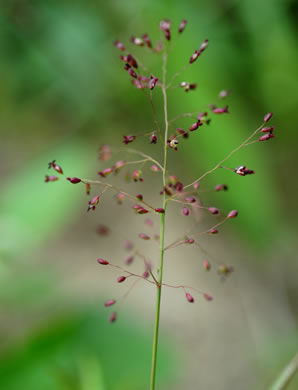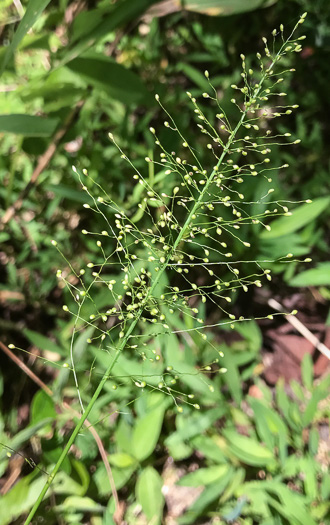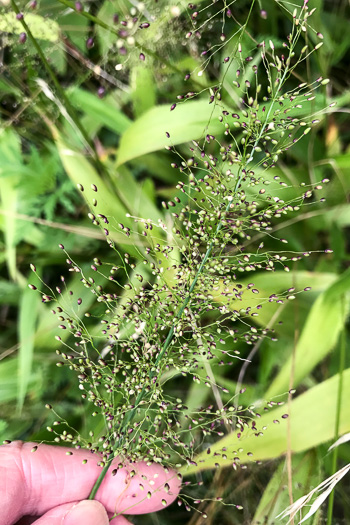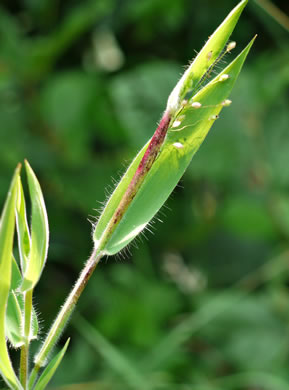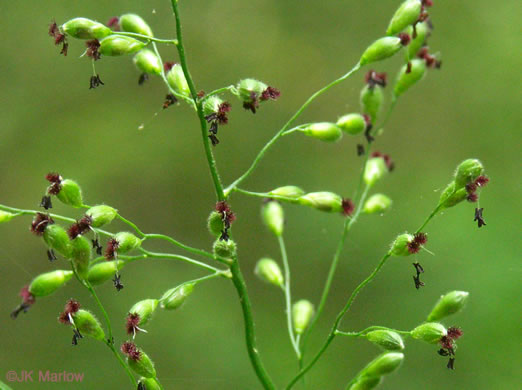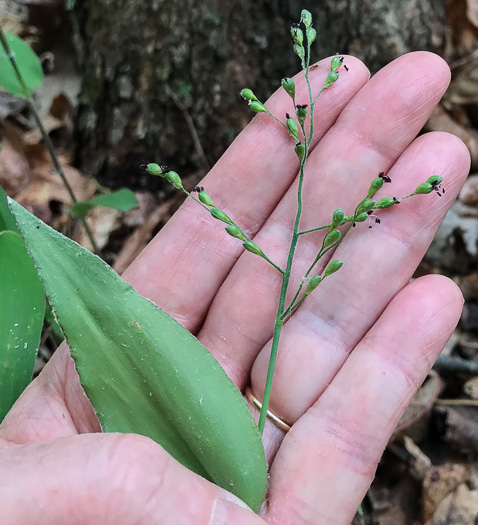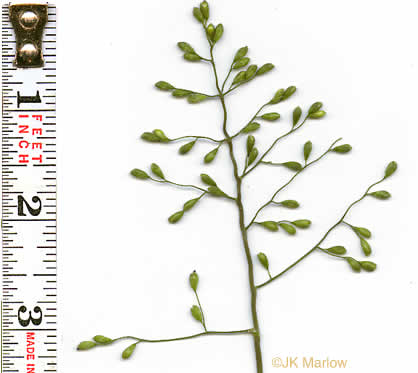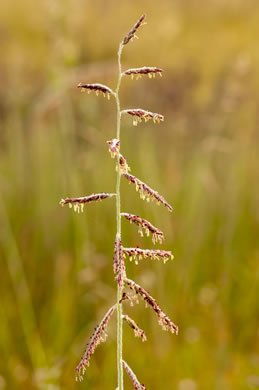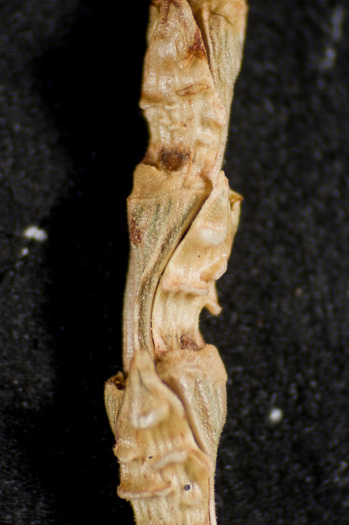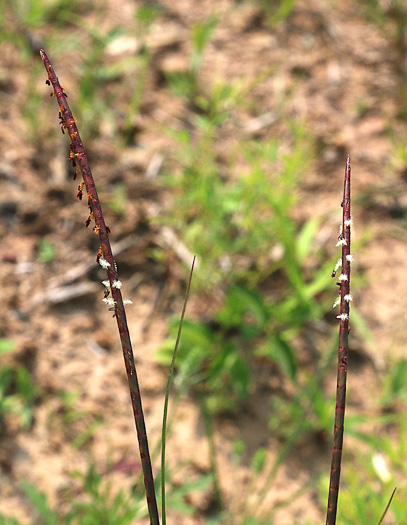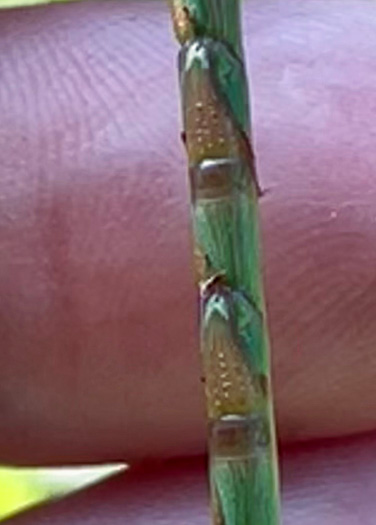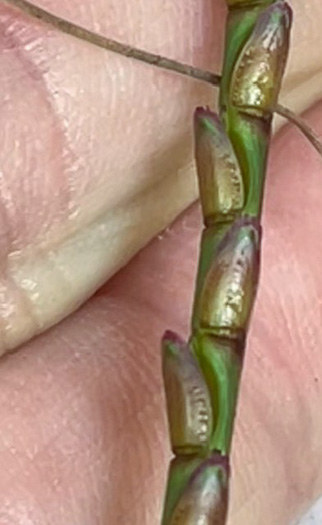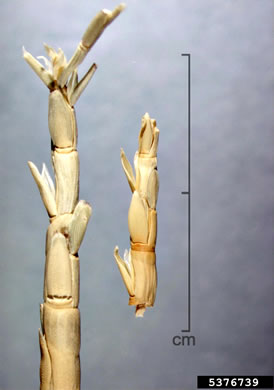Your search found 423 image(s) illustrating the term "spike." For a written explanation, click on "spike" in the Glossary.
PAGE 1 PAGE 2 PAGE 3 PAGE 4 PAGE 5 PAGE 6 PAGE 7 PAGE 8
To see larger pictures, click or hover over the thumbnails.
To go to the plant's detail page, click its name.
 Coastal Plain Bristlegrass,
Setaria corrugata
Coastal Plain Bristlegrass,
Setaria corrugata
Bristles green or purple, to 2cm long - much exceeding the spikelets, per Manual of the Grasses of the United States (Hitchcock & Chase, 1950).
 Coastal Plain Bristlegrass,
Setaria corrugata
Coastal Plain Bristlegrass,
Setaria corrugata
Bristles 1-3 below each spikelet, per Vascular Flora of the Carolinas (Radford, Ahles, & Bell, 1968).
 Nodding Foxtail Grass,
Setaria faberi
Nodding Foxtail Grass,
Setaria faberi
Panicle conspicuously nodding; spikelets about 3mm long, per Manual of the Grasses of the United States (Hitchcock & Chase, 1950).
 Dune Sandbur,
Cenchrus tribuloides
Dune Sandbur,
Cenchrus tribuloides
Involucre of spines fused into a bur; spines 4-8mm long, spikelets concealed, per Weakley's Flora (2015).
 Tender Fountaingrass,
Cenchrus setaceus
Tender Fountaingrass,
Cenchrus setaceus
Pennisetum's spikelets are surrounded by an involucre of bristles, per Manual of the Grasses of the United States (Hitchcock & Chase, 1950).
 Shortleaf Basketgrass,
Oplismenus setarius
Shortleaf Basketgrass,
Oplismenus setarius
Racemes subglobose, each w about 5 spikelets; awn of first glume 4-8mm long, per Manual of the Grasses of the United States (Hitchcock & Chase, 1950).
 Rough Barnyard-grass,
Echinochloa muricata var. muricata
Rough Barnyard-grass,
Echinochloa muricata var. muricata
Spikelets > 3.5mm long. Sterile lemma usually awned, the awn 6-25mm long, per Weakley's Flora.
 Swamp Barnyard-grass,
Echinochloa walteri
Swamp Barnyard-grass,
Echinochloa walteri
Panicle branches spikelike, spikelets congested on short secondary branches, per Wildflowers of the Eastern United States (Duncan & Duncan, 1999).
 Water Paspalum,
Paspalum fluitans
Water Paspalum,
Paspalum fluitans
Panicle branches extend beyond outermost spikelets & disarticulate at maturity, per Weakley's Flora.
 Sour Paspalum,
Paspalum conjugatum
Sour Paspalum,
Paspalum conjugatum
Spikelets solitary, ovate, light yellow, conspicuously ciliate-fringed, per Manual of the Grasses of the United States (Hitchcock & Chase, 1950).
 Dallis-grass,
Paspalum dilatatum ssp. dilatatum
Dallis-grass,
Paspalum dilatatum ssp. dilatatum
Terminal racemes with 3-7 alternate spreading branches, spikelets 4-rowed, per Forest Plants of the Southeast and Their Wildlife Uses (Miller & Miller, 2005).
 Dallis-grass,
Paspalum dilatatum ssp. dilatatum
Dallis-grass,
Paspalum dilatatum ssp. dilatatum
Spikelets ovate, acuminate, 3-4mm [anthers & feathery stigmas protruding], per Vascular Flora of the Carolinas (Radford, Ahles, & Bell, 1968).
 Dallis-grass,
Paspalum dilatatum ssp. dilatatum
Dallis-grass,
Paspalum dilatatum ssp. dilatatum
Spikelets have long silky hairs like P. urvillei, but are larger (3-3.5mm), per Wildflowers of the Eastern United States (Duncan & Duncan, 1999).
 Vasey Grass,
Paspalum urvillei
Vasey Grass,
Paspalum urvillei
Spikelets 4-rowed, light-green often with dark flowering parts extending, per Forest Plants of the Southeast and Their Wildlife Uses (Miller & Miller, 2005).
 Vasey Grass,
Paspalum urvillei
Vasey Grass,
Paspalum urvillei
Spikelets 2-3mm with conspicuous silky hairs, a rare occurrence in Paspalum, per Wildflowers of the Eastern United States (Duncan & Duncan, 1999).
 Field Crowngrass,
Paspalum laeve var. laeve
Field Crowngrass,
Paspalum laeve var. laeve
Spikelets orbicular, 2.5-3mm broad, in two rows, per Vascular Flora of the Carolinas (Radford, Ahles, & Bell, 1968).
 Early Crowngrass,
Paspalum praecox
Early Crowngrass,
Paspalum praecox
Racemes terminal, longest usually < 6cm. Spikelets flattened, yellowish-green, per Vascular Flora of the Carolinas (Radford, Ahles, & Bell, 1968).
 Florida Paspalum,
Paspalum floridanum
Florida Paspalum,
Paspalum floridanum
Racemes 3-13cm long (longest > 6cm). Spikelets in 4 rows or by abortion 3 or 2, per Vascular Flora of the Carolinas (Radford, Ahles, & Bell, 1968).
 Florida Paspalum,
Paspalum floridanum
Florida Paspalum,
Paspalum floridanum
Spikelets suborbicular or broadly ellipsoid; pedicels 1-2mm long, per Vascular Flora of the Carolinas (Radford, Ahles, & Bell, 1968).
 Florida Paspalum,
Paspalum floridanum
Florida Paspalum,
Paspalum floridanum
Spikelets 3-4mm long, flat-rounded, white waxy sometimes brown or peeling, per Forest Plants of the Southeast and Their Wildlife Uses (Miller & Miller, 2005).
 Florida Paspalum,
Paspalum floridanum
Florida Paspalum,
Paspalum floridanum
Terminal racemes with 2-7 ascending branches, w large spikelets in 2 rows, per Forest Plants of the Southeast and Their Wildlife Uses (Miller & Miller, 2005).
 Slender Crabgrass,
Digitaria filiformis var. filiformis
Slender Crabgrass,
Digitaria filiformis var. filiformis
Spikelet, showing shiny dark brown fertile lemma beneath upper glume.
 Hairy Crabgrass,
Digitaria sanguinalis
Hairy Crabgrass,
Digitaria sanguinalis
Spikelets about 3mm long, sterile lemma strongly nerved, per Manual of the Grasses of the United States (Hitchcock & Chase, 1950).
 Browntop Millet,
Urochloa ramosa
Browntop Millet,
Urochloa ramosa
Panicles of asending spikelike racemes along an angled axis, per Manual of the Grasses of the United States (Hitchcock & Chase, 1950).
 Browntop Millet,
Urochloa ramosa
Browntop Millet,
Urochloa ramosa
Spikelets borne singly in each row, 2-4mm long, per Weakley's Flora.
 Big Carpetgrass,
Axonopus furcatus
Big Carpetgrass,
Axonopus furcatus
Spikelets with lower lemmas adjacent to the branch axes (lower glumes absent), per Weakley's Flora.
 American Cupscale,
Sacciolepis striata
American Cupscale,
Sacciolepis striata
Inflorescence a slender panicle w branches so short it may appear spikelike, per Wildflowers of the Eastern United States (Duncan & Duncan, 1999).
 Beaked Panicum,
Coleataenia anceps ssp. anceps
Beaked Panicum,
Coleataenia anceps ssp. anceps
Split from Panicum because of its subsessile spikelets, among other things, per Vascular Plants of North Carolina.
 Beaked Panicum,
Coleataenia anceps ssp. anceps
Beaked Panicum,
Coleataenia anceps ssp. anceps
Rather crowded somewhat curved subsecund spikelets, set obliquely, per Manual of the Grasses of the United States (Hitchcock & Chase, 1950).
 Redtop Panicgrass,
Coleataenia rigidula ssp. rigidula
Redtop Panicgrass,
Coleataenia rigidula ssp. rigidula
Spikelets greeinish-purple, attached on 1 side of the panicle branches, per Wildflowers of Tennessee, the Ohio Valley, and the Southern Appalachians (Horn, Cathcart, Hemmerly, & Duhl, 2005).
 Seaside Panicum,
Panicum amarum
Seaside Panicum,
Panicum amarum
Spikelets of inflorescence dense, forming a narrow panicle to 14" long and 2" wide, per Guide to the Wildflowers of SC, 2nd ed. (McMillan, Porcher, Rayner, & White; 2022).
 Switchgrass,
Panicum virgatum var. virgatum
Switchgrass,
Panicum virgatum var. virgatum
Spikelets 3.5-6mm long with the tip acuminate, per Wildflowers of the Sandhills Region (Sorrie, 2011).
 Blunt Switchgrass,
Panicum virgatum var. cubense
Blunt Switchgrass,
Panicum virgatum var. cubense
Spikelets are purplish, becoming tan-colored, 2.8-3.2mm long with acute tip, per Wildflowers of the Sandhills Region (Sorrie, 2011).
 Fall Panicum,
Panicum dichotomiflorum var. dichotomiflorum
Fall Panicum,
Panicum dichotomiflorum var. dichotomiflorum
Spikelets narrowly oblong-ovate, usually about 2.5mm long, acute, per Manual of the Grasses of the United States (Hitchcock & Chase, 1950).
 Wiry Panicgrass,
Panicum flexile
Wiry Panicgrass,
Panicum flexile
Mature panicle slender, branches ascending-spreading; spikelets long-acuminate, per Weakley's Flora.
 Nerved Witchgrass,
Dichanthelium neuranthum
Nerved Witchgrass,
Dichanthelium neuranthum
Vernal panicle branches strongly ascending to erect; spikelets 1.8-2.2mm long, per Weakley's Flora.
 Sandy Woods Witchgrass,
Dichanthelium arenicoloides
Sandy Woods Witchgrass,
Dichanthelium arenicoloides
In general it resembles D. aciculare, but its spikelets are more elongate, per Vascular Plants of North Carolina.
 Ravenel's Witchgrass,
Dichanthelium ravenelii
Ravenel's Witchgrass,
Dichanthelium ravenelii
Panicle 7-12cm long. Spikelets 4-4.3mm, sparsely papillose-pubescent, per Manual of the Grasses of the United States (Hitchcock & Chase, 1950).
 Woolly Witchgrass,
Dichanthelium acuminatum var. acuminatum
Woolly Witchgrass,
Dichanthelium acuminatum var. acuminatum
Panicle 2-10cm long, branches scaberulous. Spikelets 1.4-2.2mm long, per Vascular Flora of the Carolinas (Radford, Ahles, & Bell, 1968).
 White-haired Witchgrass,
Dichanthelium villosissimum var. villosissimum
White-haired Witchgrass,
Dichanthelium villosissimum var. villosissimum
Generally distinguished by hairy foliage & spikelets, spikelet size (2-2.5mm), &
 Forked Witchgrass,
Dichanthelium dichotomum var. dichotomum
Forked Witchgrass,
Dichanthelium dichotomum var. dichotomum
Spikelets glabrous, 1.8-2.3mm long; widest vernal blades 3-8(10)mm wide, per Weakley's Flora (2020).
 Blue Witchgrass,
Dichanthelium caerulescens
Blue Witchgrass,
Dichanthelium caerulescens
Vernal panicle 3-7cm long; spikelets obovoid, turgid, glabrous, per Manual of the Grasses of the United States (Hitchcock & Chase, 1950).
 Small-fruited Witchgrass,
Dichanthelium microcarpon
Small-fruited Witchgrass,
Dichanthelium microcarpon
Differs from D. dichotomum var. dichotomum in having smaller spikelets and ...
 Small-fruited Witchgrass,
Dichanthelium microcarpon
Small-fruited Witchgrass,
Dichanthelium microcarpon
Spikelets small: 1.4-1.9 mm long, per Vascular Plants of North Carolina.
 Long-ligule Witchgrass,
Dichanthelium longiligulatum
Long-ligule Witchgrass,
Dichanthelium longiligulatum
Panicle 3-8cm long, branches spreading to ascending. Spikelets 1.2-1.5mm, per Vascular Flora of the Carolinas (Radford, Ahles, & Bell, 1968).
 Erectleaf Witchgrass,
Dichanthelium erectifolium
Erectleaf Witchgrass,
Dichanthelium erectifolium
Panicle rather narrow, densely flowered; spikelets nearly spherical, per Manual of the Grasses of the United States (Hitchcock & Chase, 1950).
 Round-fruited Witchgrass,
Dichanthelium sphaerocarpon
Round-fruited Witchgrass,
Dichanthelium sphaerocarpon
Panicle 4-13cm long, branches spreading-ascending. Spikelets 1.4-1.6mm, per Vascular Flora of the Carolinas (Radford, Ahles, & Bell, 1968).
 Many-flowered Witchgrass,
Dichanthelium polyanthes
Many-flowered Witchgrass,
Dichanthelium polyanthes
Panicle 5-20cm long. Spikelets 1.2-1.6mm, per Vascular Flora of the Carolinas (Radford, Ahles, & Bell, 1968).
 Many-flowered Witchgrass,
Dichanthelium polyanthes
Many-flowered Witchgrass,
Dichanthelium polyanthes
long-elliptical (or cylindrical) inflorescence of numerous small spikelets, per Vascular Plants of North Carolina.
 Velvet Witchgrass,
Dichanthelium scoparium
Velvet Witchgrass,
Dichanthelium scoparium
Spikelets 2.4-2.6mm long, obovate, turgid, papillose-pubescent, per Manual of the Grasses of the United States (Hitchcock & Chase, 1950).
 Bosc's Witchgrass,
Dichanthelium boscii
Bosc's Witchgrass,
Dichanthelium boscii
Spikelets 3.7-4.2mm long; rachis and spreading-ascending branches villous, per Vascular Flora of the Carolinas (Radford, Ahles, & Bell, 1968).
 Bosc's Witchgrass,
Dichanthelium boscii
Bosc's Witchgrass,
Dichanthelium boscii
Spikelets relatively large.
 Bosc's Witchgrass,
Dichanthelium boscii
Bosc's Witchgrass,
Dichanthelium boscii
Panicle 6-12cm long, spikelets 4-4.5mm long, about half as wide, per Manual of the Grasses of the United States (Hitchcock & Chase, 1950).
 Longleaf Cupgrass,
Eriochloa michauxii var. michauxii
Longleaf Cupgrass,
Eriochloa michauxii var. michauxii
Axis & raceme rachises densely velvety-pubescent; spikelets appressed-villous, per Manual of the Grasses of the United States (Hitchcock & Chase, 1950).
 Wrinkled Jointgrass,
Mnesithea rugosa
Wrinkled Jointgrass,
Mnesithea rugosa
Inflorescence section, with ridged spikelets.
 Carolina Jointgrass,
Mnesithea cylindrica
Carolina Jointgrass,
Mnesithea cylindrica
Spikelets tightly crowded one atop another, with the male section above the female section, per Vascular Plants of North Carolina.
 Carolina Jointgrass,
Mnesithea cylindrica
Carolina Jointgrass,
Mnesithea cylindrica
Each spikelet has a number of little pits (in vertical rows) on the glumes, per Vascular Plants of North Carolina.
 Carolina Jointgrass,
Mnesithea cylindrica
Carolina Jointgrass,
Mnesithea cylindrica
Sessile spikelets 4-5mm, the first glume pitted along the nerves, per Manual of the Grasses of the United States (Hitchcock & Chase, 1950).
 Itch-grass,
Rottboellia cochinchinensis
Itch-grass,
Rottboellia cochinchinensis
Spikelets awnless, in pairs at the nodes of a thickened articulate rachis, per Manual of the Grasses of the United States (Hitchcock & Chase, 1950).

